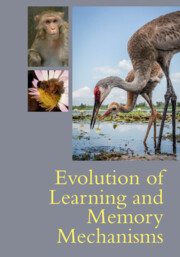Book contents
- Evolution of Learning and Memory Mechanisms
- Evolution of Learning and Memory Mechanisms
- Copyright page
- Contents
- Figures
- Tables
- Contributors
- Preface
- Introduction
- Part I Evolution of Learning Processes
- Part II Evolution of Memory Processes
- 16 The Evolution of Memory as an Immediate Perceptual Identification Mechanism
- 17 Episodic Memory in Animals
- 18 Evolutionary Origins of Complex Cognition
- 19 Evolution of Memory Systems in Animals
- 20 What Laboratory and Field Approaches Bring to Bear for Understanding the Evolution of Ursid Cognition
- 21 Distinguishing Mechanisms of Behavioral Inhibition and Self-control
- 22 Metacognitive Monitoring and Control in Monkeys
- 23 Adaptive Memory
- 24 Remembering Cheaters
- 25 Development of Memory Circuits under Epigenetic Regulation
- 26 Constraints on Learning and Memory
- Index
- References
23 - Adaptive Memory
Fitness-Relevant Tunings in Human Memory
from Part II - Evolution of Memory Processes
Published online by Cambridge University Press: 26 May 2022
- Evolution of Learning and Memory Mechanisms
- Evolution of Learning and Memory Mechanisms
- Copyright page
- Contents
- Figures
- Tables
- Contributors
- Preface
- Introduction
- Part I Evolution of Learning Processes
- Part II Evolution of Memory Processes
- 16 The Evolution of Memory as an Immediate Perceptual Identification Mechanism
- 17 Episodic Memory in Animals
- 18 Evolutionary Origins of Complex Cognition
- 19 Evolution of Memory Systems in Animals
- 20 What Laboratory and Field Approaches Bring to Bear for Understanding the Evolution of Ursid Cognition
- 21 Distinguishing Mechanisms of Behavioral Inhibition and Self-control
- 22 Metacognitive Monitoring and Control in Monkeys
- 23 Adaptive Memory
- 24 Remembering Cheaters
- 25 Development of Memory Circuits under Epigenetic Regulation
- 26 Constraints on Learning and Memory
- Index
- References
Summary
Human memory is an evolved trait, fine-tuned over generations by the process of natural selection. Using the technique of forward engineering, our laboratory has derived empirical predictions about remembering by focusing on the main criteria that drive natural selection. Memory systems must have evolved because they enhanced fitness — i.e., survival and reproduction — so we reasoned that memory’s operating characteristics likely show sensitivity to fitness dimensions. As we review in this chapter, this strategy has led to the discovery of a number of novel phenomena, some of which are among the most potent memory-enhancing techniques yet discovered in the memory field. Included in our discussion are the effects of survival processing, animacy, potential contamination from disease, and finding potential mating partners. Throughout, we consider the merits of taking an evolutionary perspective on the discovery and interpretation of mnemonic phenomena.
- Type
- Chapter
- Information
- Evolution of Learning and Memory Mechanisms , pp. 406 - 423Publisher: Cambridge University PressPrint publication year: 2022
References
- 2
- Cited by

